
|
![]()
Greatest Films of the 1930s
1930 | 1931 | 1932 | 1933 | 1934 | 1935 | 1936 | 1937 | 1938 | 1939
Title Screen Film Genre(s), Title, Year, (Country), Length, Director, Description 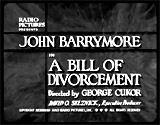

A Bill of Divorcement (1932), 70 minutes, D: George Cukor
A sensitive performance by John Barrymore. Hillary Fairfield (John Barrymore), who had been living in a mental hospital for 15 years, escaped. He returned home to his wife and family on the day his wife Margaret (Billie Burke) was divorcing him so that she could remarry. His strong-willed daughter Sydney (Katharine Hepburn, in her film debut) had always been told that he had been shell-shocked from the Great War, but now discovered from him a family history of hereditary mental illness, and she started to believe that she was next.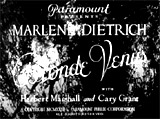

Blonde Venus (1932), 92 minutes, D: Josef von Sternberg
A camp classic and the most outlandish of the Dietrich/von Sternberg pictures. Helen Faraday (Marlene Dietrich), a nighclub-cabaret singer, was also a loving mother and wife who prostituted herself to a nightclub owner and wealthy playboy Nick Townsend (Cary Grant) in order to pay for her scientist husband Edward's (Herbert Marshall) expensive ($1,500) medical bills, so that he can go for cancer treatment in Germany. Her husband was an American chemist dying of radium poisoning. Helen (taking the named Helen Jones) began a glamorous career as a cabaret singer on the German stage. She was billed as the "Blonde Venus." The film's highlight was her bizarre, gorilla-suited "Hot Voodoo" number, to the beat of an African drum, in which she first took off her gorilla head and suit to reveal herself. She then sang the throaty song wearing a blonde Afro wig, while surrounded by archetypal 'black' dancers. As the Hays Code required, she would have to suffer the consequences as a 'fallen woman.' Upon her husband's return from treatment, he discovered her liaison with Townsend and filed for divorce and custody of their five year-old son Johnny (Dickie Moore). Forced to surrender Johnny to authorities, she eventually became an impoverished and destitute prostitute. In the end, however, in another turn-around, her estranged husband realized that her sacrifice was for his cure, and they were reconciled.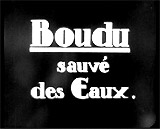

Boudu Saved From Drowning (1932, Fr.) (aka Boudu Sauvé des Eaux), 90 minutes, D: Jean Renoir
Renoir's fourth sound film - an arthouse film of social commentary which shocked and scandalized when first shown. Also a forward-looking, sophisticated and inventive film with several early experiments with deep focus and nonnaturalistic sound. With a plot similar to its Paul Mazursky remake: Down and Out in Beverly Hills (1986). Tramp Priape Boudu (Michel Simon) was rescued from a suicidal drowning in the Seine River by a Parisian bookseller named Édouard Lestingois (Charles Granval). When bum Boudu was provided with shelter in the bourgeois home of benefactors Édouard and Emma Lestingois (Marcelle Hainia), he proved to be ungrateful, loutish, deranged, destructive, lazy, smelly and dirty, rude, disgusting, and salacious. Also involved in the plot was the Lestingois' gold-digging maid Chloë Anne Marie (Sévérine Lerczinska), the husband's mistress. After winning the national lottery by a stroke of luck (finding the winning ticket in a suitcoat given him by Edouard), Boudu married Anne-Marie, but then gave up his comfortable middle-class life and fortune by literally swimming away and reverting to being a tramp.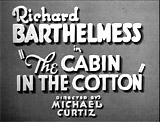

Cabin in The Cotton (1932), 77 minutes, D: Michael Curtiz
A rich, young and wicked Southern woman Madge Norwood (Bette Davis) entranced a poor sharecropper's son Marvin Blake (Richard Barthelemess), who worked at her father Lane Norwood's (Berton Churchill) general store as a night clerk. When promoted to bookkeeper, he learned how Norwood was cheating the tenant farmers, caught in the conflict between his loyalty to his employer, his love for Madge, and his roots as a farmer. The film was known for Madge's famous line: "Ah'd like to kiss ya, but ah jest washed ma hair."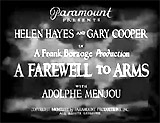


A Farewell to Arms (1932), 78 minutes, D: Frank Borzage
A sentimental, romantic, and moving film. A romanticized version of Ernest Hemingway's tragic love story. A wounded American ambulance driver Lt. Frederic Henry (Gary Cooper) fell in love with British volunteer nurse Catherine Barkley (Helen Hayes), while both serving in the war in WWI Italy. They were both brought together and separated by the circumstances of the war, and the manipulations of jealous womanizer Major Rinaldi (Adolphe Menjou).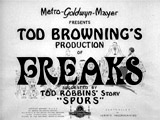


Freaks (1932), 64 minutes, D: Tod Browning
A bizarre horror film, but a cult favorite. This was a truly amazing masterpiece about a group of grotesquely deformed circus freaks (the film featured many real-life circus sideshow freaks, including "pinheads," the "living torso" Prince Randian, Siamese twins Daisy and Violet Hilton, and the half-bodied Johnny Eck, and others). A beautiful but heartless high-wire artist Cleopatra (Olga Baclanova) married a wealthy circus midget Hans (Harry Earles), but then plotted with her strongman lover Hercules (Henry Victor) to poison him to death for his inheritance money. In revenge, the group of freaks protected the midget from his bride and got even with the high-wire artist. The freaks sought retribution against strongman Hercules by crawling and slithering in the mud under the carnival wagons, with knives in their hands, as they pursued him. They transformed (off-screen) the tall and sexy Cleopatra into a legless, feathered chicken with a scarred and bruised face, drooping mouth, and a squawking mouth - she was punished for her greed, cruelty and duplicity toward one of the freaks.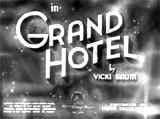


Grand Hotel (1932), 112 minutes, D: Edmund Goulding
An MGM all-star classic film and soap opera that won the Best Picture Oscar - its sole nomination. It was the best example of an all-star production heavily bankrolled by the studios. The film set a pattern for future films (known as portmanteau - or anthology - films, centered around an event, person, or location), telling stories about the lives and destinies of several individuals. They included a vivacious office stenographer, a brusque unethical businessman, a ballerina dancer, a gentleman jewel-thief, and a lowly terminally-ill bookkeeper - that were woven together into a whole. In the story, World War I was over, and Berlin's beautiful, art-deco Grand Hotel was busy with the intersecting lives and destinies of its glamorous guests in a 24-48 hour period. The dramatic ensemble cast included a weary, unloved and lonely ballerina Grusinskaya (Garbo), a financially-destitute nobleman and jewel-thief Baron Felix von Gaigern (Barrymore) who she fell in love with, a sexy, on-the-make stenographer Flaemmchen (Crawford) who met a dying clerk Otto Kringelein (Lionel Barrymore) searching for a last fling, and crude industrialist Gen. Director Preysing (Beery) seeking a business merger to avoid financial catastrophe. It was famous for highlighting Garbo's oft-quoted line: "I want to be alone."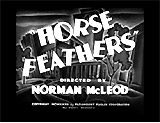

Horse Feathers (1932), 68 minutes, D: Norman Z. McLeod
One of the Marx Brother's greatest, most zany films, with numerous one-liners. Groucho was Professor Wagstaff, president of Huxley College, who mistakenly hired Chico, the local speakeasy bootlegger and iceman, and his assistant Harpo, a dogcatcher, as professional football players, so Huxley College could beat their rivals at Darwin. In the big game, Huxley won through madcap maneuvers.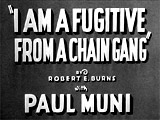


I Am a Fugitive From a Chain Gang (1932), 93 minutes, D: Mervyn LeRoy
The powerful, realistic drama of an innocent man, a World War I veteran James Allen (Paul Muni) who had been convicted, and sentenced to ten years of hard labor for a crime he didn't commit. He was trapped in a brutal Southern chain gang. Prisoners were treated inhumanely by the guards. After a prison escape through the swamps, he reestablished himself in Chicago with a normal life, but was discovered and voluntarily returned to the South, with a promise that he would be pardoned. Upon his return to prison, he was again brutalized. The film was known for its chilling climax ("I steal!"), and for its effectiveness in promoting social reform.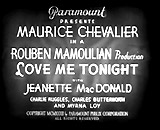


Love Me Tonight (1932), 104 minutes, D: Rouben Mamoulian
An adaptation of Rodgers and Hart's Broadway musical, with innovative direction and editing, one of the best musicals. This was a pivotal musical. It shaped the technical language of movie musicals in the sound era, by smoothly integrating the songs into the film's plotline. It also featured the first zoom shot (into a window) and the first asynchronous sound, and also other dazzling special effects such as slow-motion, fast-motion, and split-screens. This was the romantic tale of a Parisian tailor Maurice Courtelin (Maurice Chevalier) who tried to win the heart of a princess, Princess Jeanette (Jeanette MacDonald). Included the songs "Lover," "Mimi," and "Isn't It Romantic?"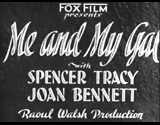



Me and My Gal (1932), 79 minutes, D: Raoul Walsh
In this low-budget, fast-talking, pre-Code streetwise romantic comedy (with crime drama elements), fresh young New York pier beat-cop Danny Dolan (Spencer Tracy) fell in love with sarcastic, strong-minded waterfront cafe waitress Helen Riley (Joan Bennett), while Helen's newly-married sister Kate (Marion Burns) still harbored feelings for an ex-boyfriend - gangster fugitive Duke Castenega (George Walsh, the director's brother), and hid him in her attic. As a pre-Prohibition film (alcohol was outlawed in 1933), it celebrated drinking. One drunken character, the father of the bride, approached the camera and asked: "Who’d like a drink, huh?"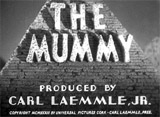

The Mummy (1932), 73 minutes, D: Karl Freund
In this classic, atmospheric, creepy pre-Code horror film, archaeologists in the early 1920s in Egypt foolishly read incantations from an ancient sacred book ("The Scroll of Toth") that resurrected a 3,700 year old Mummy, a high priest named Imhotep (Boris Karloff in his second horror starring role). It was discovered that Imhotep had not been eviscerated, but wrapped as a Mummy and buried alive. He had been sentenced to the live burial for a forbidden act of sacrilege - for attempting to revive a sacrificed vestal virgin whom he loved named Princess Ankh-es-en-Amon (Zita Johann). After the scroll reading, the Mummy escaped and ten years later was disguised as a modern Egyptian named Ardath Bey. When Bey saw Helen Grosvenor (also Zita Johann), he believed that she was his reincarnated ancient princess. Bey's objective was to kill her with a sacrificial knife, then mummify and resurrect her, and finally make her his bride. Fortunately, Helen (recalling her previous life) called upon the goddess Isis to burn the Scroll of Toth and break the spell that allowed Imhotep to live - Ardath's face crumbled and deteriorated in the film's ending.
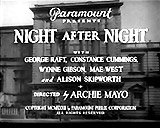


Night after Night (1932), 73 minutes, D: Archie Mayo
Mae West's first talking film, full of her notable wisecracks and one-liners in a secondary role. Joe Anton (George Raft), a reformed thug, who had many uncouth, low-life acquaintances from his past (including Mae West), opened up a night club, and attempted to woo Park Avenue, upper-class beauty Jerry Healy (Constance Cummings). During a dinner party, blonde Mandie Triplett (Mae West), one of Joe's former girls, burst in and disrupte the proceedings with her inimitable presence and dialogue.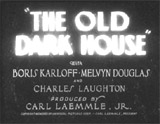



The Old Dark House (1932), 70 minutes, D: James Whale
Notable as one of James Whale's bizarre horror films, with Boris Karloff in his first film role. A theatrically creepy story of a group of stranded travelers who took shelter in the mysterious, haunted dark old house of the Femm family. The assorted collection of guests included Philip Waverton (Raymond Massey), his wife Margaret (Gloria Stuart), their friend Roger Penderell (Melvyn Douglas), Sir William Porterhouse (Charles Laughton) and his companion Gladys DuCane (Lilian Bond). The residents of the house included 102 year-old bedridden Sir Roderick Femm (Elspeth Dudgeon), a son Horace (Ernest Thesiger), daughter Rebecca (Eva Moore), and a psychotic mute butler (Boris Karloff).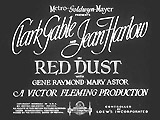


Red Dust (1932), 83 minutes, D: Victor Fleming
A steamy classic drama, with hot-blooded chemistry between the two stars. The film was remade as Mogambo (1953), starring Clark Gable (21 years older), Ava Gardner, and Grace Kelly. Dennis Carson (Clark Gable), head of a Indo Chinese rubber plantation, took in a female house guest - a flirtatious, glib, and earthy platinum blonde Saigon hooker named Vantine (Jean Harlow), running from the authorities. His lusty relationship with the wisecracking Vantine was put to the test when a boat arrived with newlyweds, an engineer Gary Willis (Gene Raymond) and his cultured, upper-class attractive wife Barbara "Babs" (Mary Astor), and Carson turned his attentions toward Barbara. Eventually torn between the two in a love triangle, he returned into the arms of his bawdy girlfriend Vantine, when wounded by a shot-gun blast from a jealous "Babs."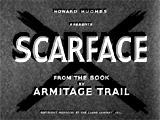


Scarface (1932) (aka Scarface, the Shame of the Nation), 90 minutes, D: Howard Hawks
A violent, fast-paced, intense crime/gangster melodrama, the 'first' of the great gangster films, although its release was delayed due to censorship battles. One of the boldest, most potent, raw and violently-brutal gangster-crime films ever made. Based on Al Capone's life, the film chronicled the rise and fall of Roaring 20's tough Chicago gangster and bootlegger Tony Camonte (Paul Muni). Tony was a brutish, primeval character, and the film portrayed scandal, violence, and 28 on-camera murders, as he confronted both his rivals led by Johnny Lovo and associates such as Guino Rinaldo (George Raft). The film was also considered controversial because of hints of incest between Tony and his sexy sister Cesca (Ann Dvorak).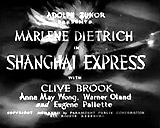


Shanghai Express (1932), 80 minutes, D: Josef von Sternberg
A romantic adventure film. While on the Shanghai Express train traveling through civil war-torn China, a couple fell into the hands of revolutionaries led by a cruel war lord Henry Chang (Warner Oland). Shanghai Lily (Marlene Dietrich), the mysterious and erotic temptress, met her ex-lover army surgeon, Captain Donald "Doc" Harvey (Clive Brook), and they rekindled their relationship when they were interrupted by rebels who attacked the train. With Shanghai Lily's famous line of dialogue: "It took more than one man to change my name to Shanghai Lily."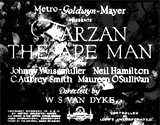


Tarzan, the Ape Man (1932), 104 minutes, D: W.S. Van Dyke
The first sound Tarzan film, and one of the best renditions of Edgar Rice Burrough's classic jungle tales. An expedition searching for elephant ivory treasures in a graveyard was met in the wilds of Africa by ape man of the jungle, Tarzan (Johnny Weismuller). He kidnapped English girl Jane (Maureen O'Sullivan), the daughter of the leader of the British expedition, and the two discovered their love for each other. Included some great action sequences.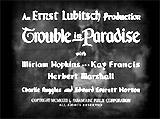
Trouble in Paradise (1932), 83 minutes, D: Ernst Lubitsch
A sophisticated, witty, comedy farce. The story of two jewel thieves Gaston Monescu/LaValle (Herbert Marshall) and Lily Vautier (Miriam Hopkins), who fell in love as they worked together to fleece widow Mme. Mariette Colet (Kay Francis) of her fortune, by posing as her secretary and maid. However, things didn't go as planned, as Gaston fell in love with Mariette, and was recognized by a former victim.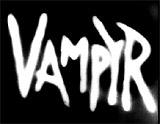

Vampyr (1932, Germ.) (aka The Vampire), 83 minutes, D: Carl Theodor Dreyer
Danish writer/director Carl Theodor Dreyer's dreamlike, atmospheric, seminal horror film (his first talkie) was loosely based on the 1872 lesbian vampire short story Carmilla by J. Sheridan Le Fanu. It was alternatively titled The Strange Adventure of David Grey - and it told the story of occult researcher Allan/David Grey (Baron Nicolas de Gunsburg, played by Julian West) in a remote country inn in the village of Courtempierre who was given a vampire combat book - "The History of Vampires". He slowly believed he was surrounded by vampires - and dreamt of his own death and glass-lidded coffin burial (filmed with a double-exposure) during a blood-loss induced fever dream.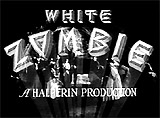

White Zombie (1932), 69 minutes, D. Victor Halperin
The grand-daddy of all modern-day zombie films of the sound era, with effective, atmospheric horror, although dated. This was Bela Lugosi's follow-up film to Dracula (1931), and his second most important movie role. The low-budget film was the archetype and model for many subsequent zombie movies. Wealthy planter and plantation owner Charles Beaumont (Robert Frazer) invited an American couple in Haiti, Neil Parker (John Harron) and his fiancee Madeline Short (Madge Bellamy), to his plantation for their marriage. On the way, they encountered the white sorcerer-master of the Haitian sugar mill, evil voodoo master Murder Legendre (Béla Lugosi), who had stocked the plantation with an army of hollow-eyed zombies under his voodoo spell. Beaumont was the lusting admirer of Madeline, but his unrequited love was rebuffed by her plans to marry Neil. With no other alternative, jealous Beaumont hired witch-doctor Legendre to use a potion to temporarily turn Madeline into a zombie. After the marriage ceremony, Madeline was slipped the potion, apparently died, and was buried in a tomb. The plan was to have her declared legally dead and have Neil return to the US. Then, Charles could secretly revive or raise Madeline from the dead and romance her. Regretful of his evil deed and due to Legendre's own dark plans for him, Charles was also transformed into a semi-zombie figure, and imprisoned in Legendre's fortified, cliff-side castle. Neil joined with missionary Dr. Bruner (Joseph Cawthorn) to rescue Madeline from the castle, where they battled both Legendre and his threatening zombie guards. During the violent confrontation, a repentant Charles broke through the voodoo spell he was under and attacked Legendre. Both Legendre and Charles fell from the fortress tower to their deaths far below on the beach. After Legendre's death, Madeline was released from her zombie state, and returned to the arms of her loving husband Neil.